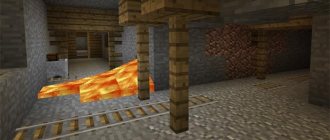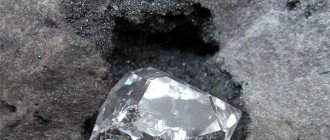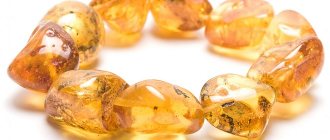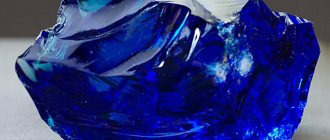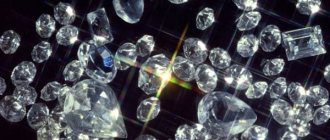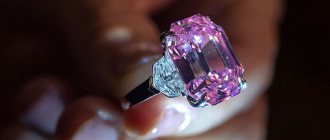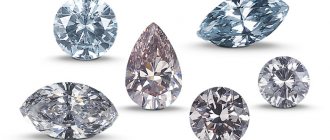Everyone knows that diamond is the most precious stone on earth. It is unique in that it is the hardest, most radiant and sparkling among minerals; its external characteristics are not subject to time, mechanical damage and even fire. Both thousands of years ago and now, diamonds attract humanity, beckoning with their cold beauty. Processed diamonds not only produce magnificent diamonds that adorn luxury jewelry, they are also (due to their properties) used in many industrial sectors. There are enough deposits where diamonds can be found in Russia to say that our country is a diamond power. In this article we will tell you more about the extraction of such a useful and beautiful mineral. So, further about where diamonds are mined in Russia: cities, location of deposits.
Diamonds in nature
In the upper mantle of the Earth, at a depth of more than 100-150 km, under the influence of high temperatures and enormous pressure, pure carbon atoms from the graphite state are modified into crystals, which we call diamonds. This crystallization process takes hundreds of years. After spending several million years in its depths, diamonds are brought to the surface of the earth by kimberlite magma during volcanic explosions. With such an explosion, so-called pipes are formed - kimberlite diamond deposits. The name “kimberlite” comes from the African town of Kimberley, in the area of which diamond-bearing rock was discovered. Nowadays, there are two types of diamond deposits: primary (lamproite and kimberlite) and secondary (placers).
Diamonds were known to mankind three thousand years before our era; the first mentions of them were found in India. People immediately endowed diamond with supernatural properties, thanks to its indestructible hardness, brilliance and transparent purity. It was accessible only to selected persons who had power and authority.
Methods for extracting diamonds from ore
The mined rock is far from diamonds, they are not even diamonds. Precious stones are isolated in different ways.
- Suspension. The rock is immersed in a high-density liquid. Stones sink, diamonds float.
- Fat. The surface on which the rock is poured with water is greased. Diamonds stick, ore is carried away by water.
- X-ray. Perfect, but unsafe option. The crystals contained in the rock glow under the rays.
- Magnet. Separates non-magnetizable diamonds from ore.
- Electric separation. The ore is passed through a stream of electricity. In accordance with the electrical conductivity coefficient, it is distributed into fractions - each mineral falls on its “own” path.
The method is determined by the composition of the rock, the level of equipment and the scale of the enterprise.
Diamond producing countries
Since each diamond is unique in its kind, it is customary to separate their accounting among world countries according to production volumes and in value terms. The bulk of diamond production is distributed among only nine countries. These are Russia, the Republic of Congo, Botswana, Australia, Canada, Angola, South Africa, Zimbabwe and Namibia.
In value terms, the leaders among these countries are Russia, African Botswana and Canada. Their total diamond production accounts for more than 60% of the value of the world's mined diamonds.
For incomplete 2021 (according to the latest data), Russia takes first place in terms of production volumes and value. Its share in value terms accounts for about 40% of total world production. This leadership has belonged to Russia for several years.
The first diamond in the Russian Federation
Now in more detail about production in our country. When and where did diamond mining in Russia first begin? This happened in the 19th century, in the summer of 1829, the serf teenager Pavel Popov, panning for gold at the Krestovozdvizhensky gold mine in the Perm province, found an incomprehensible pebble. The boy gave it to the caretaker and after assessing the precious find, he was given his freedom, and all other workers were told to pay attention to all the transparent stones. So two more diamonds were found. Humboldt, a former German geologist nearby, was told about the place where diamonds are mined in Russia. Then the development of the diamond mine began.
Over the next thirty years, about 130 diamonds were discovered, weighing a total of 60 carats. In total, before 1917, no more than 250 precious stones were found in Russia, where diamonds were mined in the Urals. But, despite the insignificant number, they were all of excellent beauty. These were stones worthy of decorating jewelry.
Already in 1937, large-scale expeditions were organized in Soviet Russia to explore Ural diamonds, but they were not crowned with great success. The placers found were poor in precious stone content; primary diamond deposits were never discovered in the Urals.
State and use of the diamond raw material base of the Russian Federation
(based on materials from the State report “On the state and use of mineral resources of the Russian Federation in 2018”)
The Russian Federation has the world's largest raw material base for diamonds - the reserves of precious stones in the depths of the country amount to almost 1,135 million carats. In addition, Russia has huge reserves of impact diamonds amounting to 268 billion carats.
Russia is also a world leader in the production of rough diamonds: in 2021, the country produced 43.2 million carats worth $3,983 million.
Characteristics of the raw material base
The basis of the Russian raw material base of diamonds, as well as the global one, is made up of primary deposits - kimberlite pipes - with placers being of subordinate importance. The domestic diamond raw material base is characterized by a high degree of concentration - almost 80% of diamond reserves are concentrated in the territory of the Republic of Sakha (Yakutia), where the unique kimberlite pipes Yubileinaya, Mir, Udachnaya, large pipes International, Nyurbinskaya, Botuobinskaya, Aikhal, Zarnitsa, and the Verkhne-Munskoye deposit are located . The quality of the ores of the deposits varies, with five of them characterized by a high level of diamond content - more than 3 carats/t. There are also placer diamond deposits on the territory of the republic, the largest of which are Nyurbinskaya and the river. Ebelyakh - are unique in terms of diamond content, and the Nyurbinskaya placer, in addition, is distinguished by a high average content of diamonds in the sands (5 carats/cub.m).
Another about 20% of domestic diamond reserves are concentrated in seven kimberlite pipes in the Arkhangelsk region, six of which (Arkhangelskaya, Karpinsky 1, Karpinsky 2, Lomonosov, Pionerskaya and Pomorskaya) make up the group of deposits named after. M.V. Lomonosov and are characterized by relatively low quality ores, containing on average from 0.09 to 1.4 carats/t of diamonds. Kimberlites from another deposit - the large pipe named after. V. Grib - comparable in diamond content to the pipes of the group of deposits named after. M.V. Lomonosov, but are of higher quality.
A small amount of diamond reserves (0.1% of Russian ones) are contained in small low-diamond placers in the river basin. Vishera in the Perm region, as well as in the sands of the Ingashetsky placer site of the Shelekhovskaya placer in the Irkutsk region.
In addition, in the Taimyr Dolgano-Nenets region of the Krasnoyarsk Territory, gigantic reserves of impact diamonds of technical quality have been explored in the Skalnoye and Udarnoye deposits, confined to the Popigai meteorite crater; their ores contain on average 7.1–18.5 carats/t of diamonds.
Almost all significant diamond deposits are licensed. The only large object of the undistributed fund is the Krasnopresnenskaya Pipe in the Republic of Sakha (Yakutia) with diamond reserves of 26 million carats, but it is characterized by extremely difficult operating conditions. In addition, gigantic reserves of impact diamonds have not been transferred for development; the prospects for their involvement in exploitation are low due to their location in a remote, undeveloped area.
Despite the fact that Russia has a rich raw material base of diamonds, in the future it may face a shortage of precious raw materials due to insufficient exploration reserves - the forecast resources of diamonds of the most reliable categories P1 and P2 are estimated at only 0.4 billion carats each. At the same time, significant predictive resources of a low degree of study - category P3 - in quantities exceeding 3 billion carats are localized on the territory of the country. The main part of the predicted resources of high categories (90% of category P1 and 80% of category P2) is localized in the depths of the Republic of Sakha (Yakutia), mainly on the flanks and deep horizons of developed fields. Only 12% and 15% of Russian predicted resources of categories P1 and P2, respectively, are concentrated in the primary objects of the Arkhangelsk region, mostly within the Zolotitsko-Kepinsky kimberlite field. Little prospects for the reproduction of the diamond raw material base are associated with the Mayardak area in the Republic of Bashkortostan, where the predicted resources of the P2 category are estimated at 23 million carats. In placer objects of the river basin. Vishera in the Perm region, a small amount of predicted resources of high-category diamonds is localized. In Siberia and the Central part of Russia, the predicted diamond resources are assessed only according to category P3.
State and prospects for development of the diamond industry
In 2021, 24 diamond deposits were developed in Russia, including 13 primary and 11 placer diamonds. 42.9 million carats of diamonds were extracted from the depths of the country. Diamond mining is carried out only in two regions: the Republic of Sakha (Yakutia) and the Arkhangelsk region. In the Republic of Sakha (Yakutia), which provides 77% of the domestic production of precious stones, the country's largest primary (Yubileinaya, Udachnaya, etc. pipes) and alluvial (Ebelyakh, Nyurbinskaya placer) deposits are being developed. The rest of Russian diamonds are mined in the Arkhangelsk region at two pipes of the group named after. M.V. Lomonosov and the tube named after. V. Grib.
The main volume of diamond production in Russia is provided by the ALROSA Group, which directly includes AK ALROSA (PJSC), as well as PJSC Severalmaz and JSC Almazy Anabara. Another company that is part of the ALROSA structure, PJSC ALROSA-Nyurba, has been in the process of liquidation since the fall of 2021. ALROSA Group enterprises develop all fields of the Republic of Sakha (Yakutia) and the group’s facilities named after. M.V. Lomonosov in the Arkhangelsk region. The structure of the ALROSA Group includes six production complexes that mine and process diamond-containing ores and sands: Aikhal, Nyurbinsky, Mirninsky, Udachninsky and Lomonosovsky GOKs, as well as the mining and processing complex of JSC Almazy Anabara. Primary deposits are developed by open pit and underground methods, placer deposits by open pit and dredge. Processing of ores and sands is carried out at processing plants at mining and processing plants, as well as seasonal sorting and processing factories (placer sands developed by Almazy Anabara JSC). In 2021, ALROSA Group enterprises produced 38.1 million carats. All of the company's developed fields were exploited, with the exception of the Mir pipe, the work of the underground mine at which was stopped due to an accident that occurred in August 2021.
The only diamond mining company in Russia that is not part of the ALROSA structure, which is part of Otkritie Holding JSC and operates the pipe named after. V. Grib in the Arkhangelsk region, processing ores at the processing plant of the mining and processing plant of the same name.
Due to the fact that almost all significant diamond deposits in Russia have already been put into production, the prospects for increasing the extraction of stones are small.
In October 2021, AK ALROSA (PJSC) brought into commercial production the Verkhne-Munskoye field, beginning open-pit development of the Polar Pipe. The deposit will be developed by two quarries with a total productivity of 3 million tons of ore per year (about 1.9 million carats of diamonds) with the involvement of four of the five kimberlite pipes included in it (Zapolyarnaya, Deimos, Novinka, Komsomolskaya-Magnitnaya). Reaching full design capacity is expected in 2024, the life of the mine will be 25 years. The mined ores are transported by road trains to the Udachny Mining and Processing Plant for processing.
In April 2021, AK ALROSA (PJSC), using the Aikhal Mining and Processing Plant, began mining ore at the Zarya kimberlite pipe, which should compensate for the retiring capacity of the Komsomolskaya pipe. During the year, it was planned to extract 100 thousand tons of ore, and in 2021 to reach full design capacity - 1.25 million tons (about 355 thousand carats of diamonds). The development of the quarry to a depth of 300 m was planned to take place over 11 years. However, in May 2021, mining operations at the Zarya pipe (as well as at the Aikhal underground mine) were suspended due to a drop in demand for diamonds on the world market caused by the COVID-19 pandemic.
The Mayskoye indigenous deposit and the associated placer of the same name are located in the area of operation of the Nyurbinsky mining and processing plant. AK ALROSA (PJSC) planned to begin construction of the quarry in 2021, and in 2025 to put these facilities into development with full capacity (300 thousand tons of ore and sand) in 2027. The development period of the deposits’ reserves will be 15 years.
Structure of the diamond industry of the Russian Federation
, operating in the Arkhangelsk region, at the end of 2021 began mining ore at the pipe named after. Karpinsky 2 from the group of deposits named after. M.V. Lomonosov, which is planned to be developed in a single quarry with the developed pipe named after. Karpinsky 1. It is assumed that on the basis of the Arkhangelsk pipe reserves, named after. Karpinsky 1 and im. Karpinsky 2, the enterprise will operate for another 29 years. In the long term, Severalmaz PJSC plans to put into operation the remaining pipes of the group of fields named after. M. V. Lomonosov: im. Lomonosov, Pionerskaya and Pomorskaya.
ALROSA Group is also implementing several projects for the development of alluvial deposits in the Republic of Sakha (Yakutia), the largest of which is Solur-Vostochnaya.
Reproduction of the diamond raw material base
In Russia, geological exploration for diamonds is carried out annually. In 2021, two alluvial objects were put on the State Balance Sheet of Mineral Reserves of the Russian Federation for the first time: the river. Billyakh (tributaries) and stream. Ochuos. A significant increase in reserves of categories A+B+C1 was obtained on the placers of the stream. Lyaseger-Yuryakh and Nyurbinskaya, as well as the Yubileinaya pipe. The total increase in diamond reserves of categories A+B+C1 due to exploration amounted to 7.3 million carats.
The bulk of diamond exploration is provided by ALROSA Group companies. In 2018-2019, additional exploration of the Yubileinaya and Zarnitsa pipes was carried out, work was carried out at the placer deposits of the Anabar and Prilensky diamond-bearing regions (Mal Kuonamka and Maspaki, Molodo, Mayat rivers, Balagannakh stream, etc.).
Early stage exploration (prospecting and evaluation) aimed at identifying new kimberlite fields and diamond deposits is also mainly carried out by ALROSA Group enterprises in the Republic of Sakha (Yakutia) and the Arkhangelsk region. In addition, prospecting for diamonds is also carried out by Proex Service LLC in the Arkhangelsk region, Almining LLC in the Perm Territory, Diamant LLC in the Leningrad region and others.
In total, in 2021, subsoil users spent 5.2 billion rubles on geological exploration work. , 13% less than in 2017. Despite significant investments, the growth rate of diamond reserves in Russia is generally low. Over the past decade, they have only twice exceeded their loss in production: in 2009 (based on the results of additional exploration of the Internatsionalnaya and Nyurbinskaya pipes) and in 2016 (exploration of the deep horizons of the Aikhal pipe, revaluation of reserves of the Verkhne-Munskoye field)
Domestic consumption and foreign trade
Rough diamonds obtained at the ALROSA Group's processing plants are supplied to the Diamond Sorting Centers in the cities. Mirny and Arkhangelsk, where they are divided into size classes and preliminary assessed. Then they are sent to the Unified Sales Organization (USO ALROSA) in Moscow and to the Yakut Diamond Trading Enterprise (YAPTA) for final sorting and evaluation according to the Ministry of Finance price list. After evaluation, gem-quality stones from various deposits are mixed and separated into “boxes” based on similar characteristics. Technical quality diamonds are supplied to the ALROSA Group subsidiary Kommeral in Mirny, where they are partially used for the production of grinding powders. The main direction of use of rough diamonds is export.
In 2021, Russian enterprises produced 43.2 million carats of rough diamonds worth $3.98 billion. The average cost of 1 carat was $92.3.
The bulk of diamonds produced in Russia are exported. In 2021, 44.7 million carats of diamonds worth $4,695 million were sold abroad. Main export destinations: Belgium, India, UAE. The average export price of Russian diamonds in 2021 was $105/carat.
The sale of diamonds mined in Russia is mainly carried out by the ALROSA Group. In 2021, it exported rough diamonds worth $3.9 billion. Export of precious stones from the country is also carried out by Foreign Economic Association Almazuvelirexport JSC and AGD DIAMONDS JSC.
Sales of the ALROSA Group on the domestic market in 2021 increased by 30% compared to the previous year, amounting to $524.5 million, including diamonds worth $0.4 million sold to Gokhran of Russia. Diamonds worth $518.5 million were purchased by cutting enterprises, which included JSC PO Kristall, NPK EPL Diamond, LLC DDK, LLC S. D. Diamond", LLC "Crystaldiam", LLC "Diapur".
In addition, jewelry diamonds worth $141.1 million were shipped to enterprises that are part of the ALROSA Group: the DIAMONDS ALROSA branch in Moscow, OREL ALROSA LLC in Orel and DIAMONDS ALROSA LLC in Orel. Barnaul. Since September 2021, the largest cutting enterprise in Russia, JSC PO Kristall, has been part of the ALROSA Group.
Russia imports a small amount of diamonds every year. In 2018, the country purchased 919 thousand carats for $296.5 million. The main volume of stones was purchased in Belgium, Hong Kong, and the UAE. All of these countries are re-exporters of diamonds; stones are not mined in any of them.
The apparent domestic consumption of diamonds in Russia in 2021 can be estimated at $956 million, taking into account sales of stones within the country (including to Gokhran of Russia), supplies to cutting plants of AK ALROSA (PJSC) and imports. This is a third higher than the 2021 level, mainly due to an increase in payment deferrals for domestic consumers. Russia's share in the total consumption of rough diamonds ($15.5 billion in 2021 according to Tacy Ltd) is only about 6%.
Main conclusions
Thanks to the presence of a powerful diamond raw material base and its effective development, the Russian Federation has for a long period maintained the world leadership in the production of natural rough diamonds. However, if the current level of production is maintained, a significant reduction in the diamond raw material base is possible in the long term.
Geological exploration for diamonds is ongoing, but the rate of reproduction of diamond reserves is low. The main thing is that over the past decade, not a single deposit has been discovered that is comparable in terms of diamond potential to the objects that currently provide the bulk of stone production.
All this, taking into account the shutdown of the mine at one of the largest domestic diamond deposits - the Mir pipe, may negatively affect the prospects of the country's diamond mining industry. To create a sufficient prospecting reserve, it is necessary to carry out work in areas with localized forecast resources P3, primarily in the north and south of the Republic of Sakha (Yakutia), as well as in Siberia (Irkutsk region, Krasnoyarsk Territory) and in the north-west of the country (Arkhangelsk region and the Republic of Karelia). It is also advisable to carry out geological exploration in order to identify objects with a low diamond content, but high quality stones.
Source:
State report “On the state and use of mineral resources of the Russian Federation in 2021”
https://www.mnr.gov.ru/docs/gosudarstvennye_doklady/gosudarstvenny_doklad_o_sostoyaniy_i_ispolzovanii_mineralno_syrevykh_resursov_rossiyskoy_federatsii/
Anastasia Smolnikova for Rough&Polished
Siberian diamonds
Since the 18th century, the best minds of our country have wondered where the diamond deposits are in Russia. The great Russian scientist of the 18th century, Mikhail Lomonosov, stated in his writings that Siberia could be a diamond-bearing region. He outlined his assumption in the manuscript “Diamonds Could Have Occurred in the Northern Lands.” However, the first Siberian diamond was found at the end of the 19th century on the Melnichnaya River, near the city of Yeniseisk. Due to the fact that it weighed only two-thirds of a carat, and also due to a lack of funding, exploration of other diamonds in the area was not continued.
And only in 1949 in Yakutia on the Sokolinaya Spit, near the village of Krestya in the Suntarsky Ulus, the first Siberian diamond was found. But this deposit was alluvial. The search for indigenous kimberlite pipes was crowned with success five years later - the first pipe not located in Africa was found near the Daldyn River by geologist Popugaeva. This was a significant discovery in the life of our country. The name of the first diamond-bearing pipe was given in the Soviet style of that time - “Zarnitsa”. The next to be discovered were the Mir pipe and the Udachnaya pipe, where diamonds are still mined in Russia. By the end of 1955, 15 new diamond pipe deposits appeared in Yakutia.
Yakutia, or as the locals call this region, the Republic of Sakha, is the place where gold and diamonds are mined in Russia. Despite the severity of the climate, it is a fertile and generous region, giving our country natural resources.
Below is a map that clearly shows where these precious stones are mined in Russia. The darkest territories are the places where there are the largest number of deposits, and the diamonds themselves are the most expensive in value. As you can see, most of the pipes are concentrated in the Republic of Sakha (Yakutia). There are also diamonds in the Krasnoyarsk Territory, Irkutsk Region, the Republic of Karelia, the Arkhangelsk and Murmansk Regions, the Perm Territory, the Komi Republic and so on.
Technological cycle
Diamond mining is a project that requires financial investment. Funds are needed for geological exploration, equipment, construction of a processing plant, payment of workers, and preparation of deposits.
The technology of work involves the following stages:
- Geological exploration. It takes months or years. When precious crystals are discovered, calculations are carried out to confirm that this is a solid deposit and not isolated finds.
- Purchase of equipment. Diamonds are not mined by hand; equipment is needed to set up the mine and transport to move the rock.
- Creation of infrastructure. The field employs people who need somewhere to live, eat, and receive treatment. Often a mine becomes a city-forming enterprise.
- Construction of a factory. Selling raw materials is unprofitable, so a beneficiation plant is built, where precious stones are separated from the rock, sorted and sent to a cutting plant. Here the material will be processed, cut and polished.
The deeper the rock lies, the more substantial the investment. To obtain one carat, a ton of mine rock is processed. Placers are more generous - a ton of rock yields from three to five carats.
Mirny is the city with the most diamonds in Russia
In the summer of 1955, geologists searching for kimberlite pipes in Yakutia saw a larch tree with exposed roots. This fox dug a hole here. The color of the scattered earth was bluish, which is a characteristic feature of kimberlite. The geologists were not mistaken in their guesses, and after some time they sent a coded message to the top Soviet leadership: “We smoked the pipe of peace, the tobacco is excellent!” A year later, in the west of Yakutia, large-scale development of the Mir kimberlite pipe begins, similar to quarry excavations.
Around a huge quarry in the form of a funnel, a village is formed, named in his honor - Mirny. Within two years, the village turns into the city of Mirny, today it is a city with a population of more than three tens of thousands of residents, 80% of whom are employed in the diamond mining enterprise. It can rightfully be called the diamond capital of Russia, because millions of dollars worth of diamonds are mined here every year.
Now it is the largest quarry not only in Russia, where diamonds are mined, but throughout the world. The depth of the huge quarry is 525 meters, its diameter is about 1200 meters, the quarry could easily accommodate the Ostankino TV tower. And when descending to the center of the quarry, the length of the serpentine road is more than 8 kilometers.
Below in the photo is just this diamond quarry (Mirny, Yakutia).
Take no prisoners
In 2014, things were tense at one of the meetings with Deputy Prime Minister Yuri Trutnev. The fate of Alrosa and its IPO was being decided, and Trutnev was and remains the main curator of this state corporation. “Perhaps I forgot to introduce myself? My name is Yuri Trutnev, I work as Deputy Prime Minister. I would like to remind you that this is not your personal company, but a state corporation,” he turned to a man in a black suit, who pretended not to hear the high official. He took his eyes off the phone, looked carefully at the Deputy Prime Minister and replied: “We’ll see.” Meet Fedor Andreev, director of Alrosa in 2014. It is his legacy that is now being dealt with by the new management of the company, who took their seats after a protracted war. Interlocutors close to the industry call Andreev a person who has aggravated the situation in the Russian jewelry industry, but they respectfully repeat the same phrase: “Fedya is a man without brakes, but a real warrior.” Yuri Trutnev had long wanted to change Andreev, since, to put it mildly, he did not agree with Alrosa’s policy and its IPO strategy.
“In short, the previous management decided to increase capitalization at any cost, giving up on everything, and then suddenly sell. As a result, the market sank monstrously, and then the crisis hit. The new team will have to take more than one year to sort all this out.” The hotel lobby is getting crowded, and a participant in those corporate wars sitting across from me asks for a new portion of herbal tea. This is not a five minute story. They say that the Graff company, when buying a diamond, puts it in a special machine to discharge it: it is believed that these stones accumulate energy, so before handing them over to the client, you should get rid of it. It continues to rain outside, my interlocutor slowly draws diagrams and graphs on a piece of paper explaining what is happening in the Russian diamond industry, then hands it to me. I understand that in the case of Russian diamonds, a cunning machine that removes negative energy must be the size of the Large Hadron Collider.
In the case of Russian diamonds, the cunning machine that removes negative energy should be the size of the Large Hadron Collider.
Alrosa is a giant corporation. According to the SPARK service, the main shares in the corporation are divided between the Russian Federation, represented by the Federal Property Management Agency and the government of Yakutia (50 and 32%, respectively). After the company went public in 2013, even a group of American Hasidic jewelers was among the shareholders. “They tried to demand some kind of reporting, which, of course, amused everyone a lot. But okay, it can’t go on like this for long, the dark corners will someday brighten up,” says a participant in that famous meeting with Trutnev.
The company tried to go public by any means necessary. Judging by the reports, everything seemed to be looking good: in 2014, revenue increased by 23%, amounting to 204.7 billion rubles, but the Russian diamond market hardly benefited from this. “Extract, extract and extract again. That was the strategy. Give everything abroad under contracts through various schemes, and organize auctions for the Russian market,” says a source familiar with the course of the conflict.
All the jewelers with whom I tried to discuss working with Alrosa actually switched to a conspiratorial whisper and suggested either discussing the topic over the phone or abandoning the idea altogether. “I won’t say anything new if you know about the Trutnev-Andreev conflict,” nervous chuckles are heard on the phone.
Yuri Trutnev, who for several years tried to overthrow Fyodor Andreev, who is called a protege of Alexei Kudrin, believed that the company, to put it mildly, was not acting entirely in the interests of the state, making a profit from opaque diamond transactions, but in the interests of specific management. “Even the Accounts Chamber conducted an audit, which in the public part only reported that not everything was clean with the transactions of the mid-2000s, when Andreev did not yet exist, but in the part that was not published, there were no less funny details,” recalls participant in corporate battles.
Don’t get involved - he’ll kill you, the administrative conflict between Andreev and Trutnev touched everyone on a tangent, it was better for Russian jewelers to just stand on the sidelines. The head of Yakutia, Yegor Borisov, was nervous - the republican structures, which have the right to purchase raw materials on preferential terms, quite successfully sold them to India under contracts, and when such big guys argue, the devil knows how everything will turn out. Incriminating evidence wandered from office to office, delegations were on duty in Vladimir Putin’s reception room, competing to see who would be the first to receive an audience. At the height of the corporate wars, Andreev was diagnosed with cancer, but this did not stop him.
A double-headed eagle made of rough natural diamonds is on display at the Alrosa Museum.
“In 2014, he went to Germany, where he was told that things were bad, he needed to rest for at least a few months. Fedor spent several days in the clinic and went back to Russia to fight. You can treat him any way you like, but he is a warrior,” Trutnev’s supporter in this fight leans back in his chair and falls silent for a while. Fedor Andreev lost his war in September 2014. Formally, his departure was due to health reasons, but a man in a good suit sitting opposite me shakes his head negatively: “He would have fought still, absolutely not caring about possible death, but Trutnev won.” After leaving his post, Andreev began to rapidly fade away and died in 2015. This happens, his enemies say, when a person realizes that the fight is over and there is no point in fighting further.
"Yakutalmaz"
The Yakutalmaz trust was created in 1957 in the tent village of Mirny at that time with the aim of developing mining operations for diamond extraction. Exploration of the following deposits was carried out in the difficult conditions of the deep taiga, with severe frosts of 60 degrees and the absence of any infrastructure. Thus, in 1961, almost near the Arctic Circle, the development of the Aikhal pipe began, and in 1969 another pipe was discovered - the International pipe - the most diamond-bearing pipe to date.
In the 1970s and 1980s, several more diamond mines were opened through underground nuclear explosions. The International, Yubileynaya, and other pipes were discovered in this way. In the same years, Yakutalmaz opened the world’s only kimberlite museum in the city of Mirny. At first, the exhibits represented private collections of geologists, but over time they became more numerous. Here you can see various rocks of kimberlite - a harbinger of diamonds, from different kimberlite pipes around the world.
Sharp edges of socialism
When you start talking about the vicissitudes of the domestic diamond market with Russian jewelers, the first thing you hear in response is a heavy sigh. Petr Aksenov, founder of the jewelry brand Axenoff Jewelery, whose collection you could see on the heroes of the BBC series “War and Peace,” says with obvious nostalgia that in pre-revolutionary Russia they treated diamonds much more reverently than in Soviet Russia. “I studied the historical side of the issue a lot. If it weren’t for large orders from the Russian tsars, there would be no companies like Cartier or Van Cleef. Nicholas II once attended the grand opening of the bridge in Paris. After the opening, the reception began, but he said that first he needed to stop at Van Cleef... - he sighs. “Then the revolution happened and there was no time for jewelry in the country. Have you been to the Diamond Fund? Go and look at the work of modern masters: very cool technique, I can’t imagine how they do it. But pay attention: ceramics, silver, platinum, but with stones everything is very poor. This is the jewelry industry in Russia now.”
I see no reason not to believe.
At 11 am on Wednesday at the Borovitsky Gate, where the entrance to the Gokhran branch is located, there was only me, a couple of Finns and several families from the provinces. While we are standing in line at the frame, the gates open and black cars with flashing lights slowly creep out. I remember how many crazy people tried to drive their cars here at different times, but ran into machine gun fire from the guards. Maybe no one told them about the ticket offices in the Alexander Garden, which offer entry through the Borovitsky Gate for only 500 rubles? On one of the display cases there are works by Ilgiz Fazulzyanov. Aksenov speaks about him exclusively in expressions like “the coolest”, “go crazy” and “I’m still far from him.” There are some really beautiful jewelry on display - necklaces, brooches. I hang out for a while, but gradually it dawns on me that there are only one or two diamonds in them and I’ve missed them. “Do you understand what I mean now?” – Aksenov laments. I understand, Peter, I understand.
The Diamond Fund of Gokhran has such an exhibit - a map of Russia, made entirely of diamonds. It’s unbearable to look at, not so much because of its kitsch, but because of its powerful shine. If you believe the statistics of Alrosa, which reports that almost 90% of the diamonds present on the world market are mined in the Russian Federation, then the logic of the authors of this map is clear. If you delve into the essence, it becomes clear that Russia should be a black spot on the diamond map of the world. The Russian diamond market doesn't seem to be a very fun place. Yana Raskovalova, owner of the Yana brand, one of the few Russian jewelry brands that is interesting to foreign buyers, thinks so. Both she and Aksenov, without saying a word, admit: “The problem is that the industry was killed by the Soviet regime.” Perhaps the decline in any industry can be explained by the rise of socialism, which ended, according to some, in “the greatest geopolitical catastrophe of the century,” but both jewelers say that this skating rink was especially harsh in their field. “Actually, for whom should jewelry exist in the USSR?” – Aksenov asks a rhetorical question. Raskovalova nods: “Someone was killed, someone left for other countries. While the jewelry industry was developing all over the world, we stood still.”
ALROSA
Since 1992, the legal successor of the Soviet "Yakutalmaz" has become a joint stock company with a state controlling stake. Since its formation, ALROSA has received a state monopoly on exploration, mining and diamond processing activities in the Russian Federation. This group of diamond mining and processing enterprises produces about 98% of all diamonds in Russia.
Today ALROSA has six mining and processing complexes (GOK), four of which are part of the group. These are Aikhal, Udachninsky, Mirny and Nyurbinsky mining and processing plants. Two more plants, Almazy Anabara and Arkhangelsk Severalmaz, are subsidiaries of ALROSA. Each mining and processing plant consists of one or more diamond deposits and a complex of special equipment and processing facilities.
From all mills in Russia, diamonds, no matter where they were mined, are delivered to the Diamond Sorting Center. Here they are assessed, weighed and initially processed. Then the rough diamonds are sent to Moscow and Yakut cutting plants.
Industrial processing of diamond ore
Wet autogenous grinding mill
The extracted rock from diamond mines is sent to processing plants, which are located near the deposits. Since rock layers can reach 1.5 - 2 meters, at the first stage they are crushed into smaller ones. This is done using jaw crushers; the output is raw materials crushed to 50 cm.
At the next stage, the crushed pores are sorted using a vibrating sieve; it consists of several tiers, each subsequent one has smaller fractions. Using pulsating jets of water, the waste rock is separated from the diamond compounds. This method is applied to stones of large and medium fractions.
For fine-grained material, pneumofloration is used - the use of chemical reagents, interacting with water, they form foam to which diamond particles stick.
Pneumatic flotation machine
These methods, along with diamonds, also allow ore particles to pass through, so another cleaning method is used using X-rays.
The conveyor delivers the raw materials to specially equipped containers, where the ore is irradiated; when the beam hits them, the diamonds luminesce, which is responded to by air supply units that blow the stone out of the total mass. This is the most effective cleaning method, but, unfortunately, it does not remove impurities from the stones.
Therefore, the share of manual labor at processing plants is high. After industrial processing, each stone goes through at least three more specialists who remove unnecessary impurities and sort it by size and degree of purity.
The largest deposits in Russia
Among the largest deposits in Yakutia is about. Diamond mining on an industrial scale began here in 1986, and to date the depth of development has reached 320 meters. Further development of Yubileiny up to 720 meters is predicted. Diamond reserves here are estimated at 153 million carats.
The Yubileiny diamond quarry is slightly inferior to the Udachny diamond quarry, which has reserves of precious stones worth 152 million carats. In addition, the Udachnaya pipe was discovered among the very first diamond-bearing pipes in Yakutia in 1955. And although open-pit diamond mining here closed in 2015, underground mining may still continue for several decades. The depth of the Udachny deposit at the time of closure was a world record – 640 meters.
The Mir deposit has also been closed since 2001, and diamond mining here is carried out underground. The oldest quarry also produces surprisingly large diamonds - in 2012, a specimen of 79.9 carats was found. The name of this diamond was given to “President”. True, it is 4 times smaller than the diamond with the name “XXVI Congress of the CPSU” also mined in the Mir pipe in 1980 and weighing 342.5 carats. The total reserves of the Mir quarry are estimated at 141 million carats.
“Yubileiny”, “Udachny”, and “Mir” are the largest diamond deposits not only in Russia, but also in the world.
The Botoubinskaya kimberlite pipe is one of the young, recently developed deposits, also located in Yakutia. Industrial-scale development here began in 2012, and Botouba diamonds entered the world market in 2015. Experts predict that diamond production from this deposit will amount to 71 million carats, and its service life will be at least forty years.
Related materials
00:04 — March 13, 2018
Got fed up
Russia is afraid of Belarusian milk.
Lukashenko is furious For example, Alrosa sells almost half of its diamonds in Belgium at the Antwerp World Diamond Center (AWDC) - this is an analogue of an endless exhibition where everyone can get acquainted with the products of different diamond miners. Fairs, conferences and forums of the diamond mining industry are also held here. Bidding for top stones is carried out in the format of auctions, contracts for large deliveries are concluded in meeting rooms.
The main cutter on the planet (India) accounts for about 17 percent of the Russian company's sales, another 11 percent to Israel, and Alrosa sells only 10 percent in Russia. In 2021, the company generated approximately $4.2 billion in rough sales and less than $100 million in polished sales. In addition to long-term contracts, the Russian company sells raw materials on the spot market, and valuable and unique stones at auctions.
Russia occupies a tiny share in the global diamond cutting market - only 3-4 percent, losing out to competition from the huge Indian industry. Jewelers in India process 12 of the 14 diamonds sold in the world. The secret of Indian success is not only in the traditions of jewelry making and the gigantic local market, but also in the availability of cheap labor.
Until 2021, Russian cutters worked with Alrosa on a common basis. With foreign ones, it turned out that Russian companies did not receive any priority over foreigners when selecting rough diamonds. According to Reuters, Alrosa now has 65 regular buyers (of which only eight are Russian) for jewelry and industrial diamonds, contracts with which are concluded for three years. In January, the supervisory board of Alrosa obliged to increase supplies of rough diamonds weighing more than one carat to Russian cutting enterprises. The decision was made with the participation of Finance Minister Anton Siluanov, who heads the supervisory board of the state-owned company.
Photo: Dmitry Korotaev / Kommersant
Also, to develop the diamond cutting industry, Alrosa allowed cutting companies to pay up to 75 percent of the cost of diamonds in installments for six months. Previously, this share was 50 percent - companies often did not have time to complete the work and sell the product; the new rules should help domestic cutters. The key lobbyist for expanding the rights of cutters on the Russian market is another state-owned enterprise - cutting, which is 100 percent owned by the state. This company accounts for about 40 percent of all Russian diamonds.
Deputy Finance Minister Alexei Moiseev admitted in March that the state would go ahead with the privatization of Kristall, but the official did not talk about the timing or volume of the placement. Of course, Alrosa is showing interest in the main cutting enterprise in Russia.
With an eye on the giant Asian markets, in September 2021, Alrosa opened its own trading platform in Vladivostok - the Eurasian Diamond Center (EDC), which includes stands for cutting enterprises, exhibition halls and offices, customs posts and Gokhran enterprises.
Eurasian Diamond Center in Vladivostok
Photo: Eurasian Diamond Center
The simplified customs and visa rules of the free port of Vladivostok facilitate the acceleration of purchase and sale transactions of rough and polished diamonds. The most expensive diamond sold in Vladivostok cost 752 thousand dollars. Last year, the company sold $72 million worth of rough and polished diamonds at the EAC, and the plan for 2021 is to sell $80 million worth of products.
Foreigners have flocked to the diamond cluster in the Far East: last fall, the Indian company KGK Diamonds launched a cutting plant in Vladivostok with a processing capacity of 15 thousand carats of diamonds per year.
Where are diamonds mined in Russia (except Yakutia)
The opinion that the ALROSA group of companies operates only in cold Yakutia will be erroneous. Moreover, ALROSA is developing deposits not only in Russia, where diamonds are mined, but also in ten other countries.
Indeed, the group’s basic production is concentrated in the Republic of Sakha - in the cities of Yakutsk, Mirny and other cities of Western Yakutia. But there are also representative offices of the joint-stock company ALROSA in other regions of Russia. For example, a subsidiary diamond mining enterprise in the Arkhangelsk region, where the development of diamond deposits began quite recently, about 20 years ago, and the Lomonosov Mining and Processing Plant was opened.
There are also placer diamond deposits in the Perm region. Here they concentrated in the city of Aleksandrovsk and Krasnovishersky district. Although the Permian deposits are not primary, the diamonds mined here are of high quality and are recognized as one of the best for jewelry for their transparency and purity.
ALROSA also has its own representative offices in other cities of Russia, where diamonds are not mined, but processed and turned into polished diamonds. These are Yakutsk, Moscow, St. Petersburg, Orel and a number of other cities.
Extraction methods
There are three types of developments through which gems are mined.
Career
In this way, diamonds are mined at a depth of up to 600, less often 1000 meters. First, wells are drilled and explosives are placed in them. The resulting rock is transported to the processing plant by truck.
Mine
A tunnel is dug deep into the earth to a depth of 500–1000 meters, then infrastructure is built - a ventilation system, elevators, transport for delivering workers, trolleys for mined ore, roads for bulldozers and other equipment.
Placers
Placer diamond deposits make it possible to find crystals without digging holes and tunnels. An ancient and cheap mining method based on washing rock using large sieves.
On the topic of stone mining, watch the video:
ALROSA outside Russia
AK ALROSA conducts major activities in the South African Republic of Angola. Here she owns about 33% of the shares of the local mining company - Africa's largest diamond producer. Cooperation began in 2002, after several meetings at the level of senior management in the capital of the republic, the city of Luanda, an ALROSA branch was opened.
In marketing its specific products, ALROSA has opened several sales branches around the world - in London (UK), Antwerp (Belgium), Hong Kong (China), Dubai (United Arab Emirates), as well as in the USA and Israel. These countries are the location of the main rough and polished diamond trading centers, where they are sold at special auctions and tenders.
